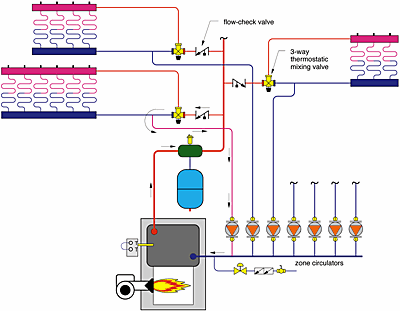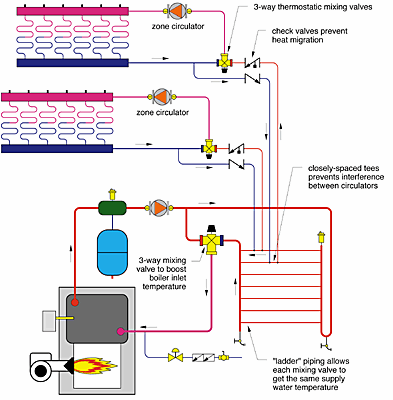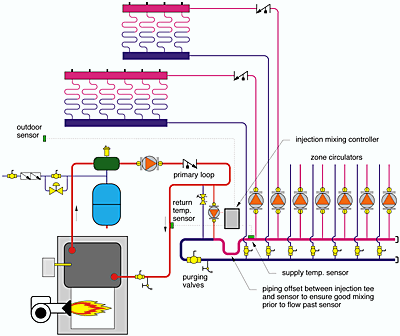Municipal Makeover
John Siegenthaler, PE

A couple committee members speak favorably of the comfort they have experienced in other radiant heating installations. They press hard for its inclusion in "their" new building. You think back to how much time you've spent with your feet on ice-cold slab floors in other buildings.
Finally you're won over, and along with the other committee members approve the architect to include radiant floor heating in the plans. Now you eagerly await the thermal delights, as well as numerous opportunities to tell others that you helped make the wise decision to use HRF heating.
Fast-forward two years. The new town office building is under construction. A section in the architect's specifications reads something to the effect: A hydronic radiant floor heating system shall be installed. This allows the system to be "designed" and installed by a couple of local P&H guys. They're familiar with hydronic baseboard systems, but not HRF heating. Their mindset: "How different can this radiant heating stuff be from what we usually install? Hey, it's just a matter of adding a few tempering valves to those zone circuits. Yeah, we can do that."
Fast-forward to January of the building's first winter. The system they install struggles to keep the building at 55 degrees F. The town supervisor shivers. The town clerk shivers. Even those hauled into court in handcuffs shiver, as does the Justice of the Peace (who, by the way, has the advantage of wearing a long black robe). The oil-fired boiler fires several times every day, both winter and summer, but where is the promised thermal bliss?
The original proponents on the planning committee can't explain what went wrong. Neither can the installers. It isn't long before local opinions regarding radiant floor heating head south. Tempers warm as toes cool. The town's attorney is put on "standby."

Takin' A Short Cut
After agreeing to review the situation, I received some photos taken while the building was under construction. From them I concluded the installers did put enough tubing in the slab. The circuit lengths appeared reasonable, and the underside of the floor was fully insulated. Whatever the problem was, it could probably be accessed without a jackhammer.Once inside the mechanical room the gremlins underlying the symptoms revealed themselves. The building had been divided into seven zones, each with a manifold supplied by a thermostat-operated zone circulator. Notice the placement of the circulators in Figure 1. They're located on a header leading into the boiler. In fact, they're located right where the installer puts them in a multiple zone baseboard system.
When flow leaves a circulator in a closed loop system, its only concern is getting back to the inlet side of that circulator. Frankly, it doesn't care if the proper amount of heat comes along for the ride. It also pays no attention to the neatly drawn arrows on your schematics, even if you leave the plans displayed on the wall in the mechanical room!
When I visited the project, the tubes leaving the mechanical room headed for the manifolds were scalding hot, (150-170 degrees F). The tubes returning from the manifolds where cold (60-70 degrees F). The high temperature drop was a sure sign of flow starvation in the distribution system.
When circulators are installed as shown in Figure 1, most of the hot water entering the mixing valve "side steps" through and around the valve spooling and heads back toward the circulator through the cold port. From the water's standpoint this path offers considerably less resistance than does the trip all the way through a floor circuit. Very small amounts of hot water (apparently only those molecules with a sense of fair play), manage to carry a few Btus to the manifold stations.
So what's the fix? Those of you who've installed three-way thermostatic valves have probably already come up with a solution to this part of the problem: just relocate the circulators between the mix port of the valves and the manifolds.
Yes, this gets the supply temperatures and manifold flow back in line. But is it a total "system solution?" No. This piping arrangement still doesn't protect the conventional oil-fired boiler against low-return water temperature. Doing so requires a device that measures boiler inlet temperature, and reacts by restricting the flow of hot water into the distribution system when necessary to keep the boiler out of condensing-mode operation.
One option would be to install another, larger, three-way thermostatic valve as shown in Figure 2. A circulator is required between this valve and the boiler. When the boiler is cool, this valve reroutes water leaving the boiler right back into the boiler. This allows the boiler to warm above condensing-mode operation as fast as possible, without being "lugged down" by a cold distribution system.
When the valve's thermostatic element determines the boiler return temperature is above its setting (say 130 degrees F), it allows flow of hot water through the outer portion of the loop. The piping to the right of the valve forms a split primary loop. Each zone subassembly is connected to a crossover pipe.
This delivers the same (hot) water temperature to each zone mixing valve, and prevents interference between the circulators. The flow-check and swing check valves shown in each loop prevent heat migration when the zone is off.
Another possibility was to eliminate the three-way thermostatic valves and convert the system to a single mixing controller, such as a motorized four-way mixing valve or variable- speed injection system. Both of these devices could regulate the supply temperature, as well as limit heat flow when necessary to protect the boiler from low inlet temperatures. Both would also allow the system to enjoy the benefits of outdoor reset control, which was not possible with the three-way thermostatic valves.
Since most of the floor coverings had similar resistance, we elected to convert the system to a single injection mixing control configured for outdoor reset.
This would allow the distribution circulators to operate most of the time, improving comfort and shuttling heat to an area of high heat loss when necessary. Since the water temperature supplied to the floor circuits is just high enough to meet the load based on the current outdoor temperature, a given distribution circulator should only turn off when internal heat gains are present in that zone.

Waste Not
A schematic for the reworked piping and controls is shown in Figure 3. Much of the existing hardware was salvaged. The expansion tank was relocated near the inlet of the zone circulators. The boiler is now "demand fired" when one or more of the zones requires heat.Originally, the burner was operated using the full intelligence of a copper jumper wire connected across the "T T" terminals in the limit control. This explains why the boiler fired 365 days a years regardless of load. Any oil burned between early May and late September simply helped exercise the building's cooling system. Burn oil to buy electricity -- sounds like a scheme only Enron could think up.
The revised system now delivers the comfort and fuel efficiency originally promised. To their credit, the original installers "bit the bullet" and willingly made the necessary modifications. In the process, they saw first hand how a modern microprocessor-controlled mixing system works, and the benefits it offers. I think they'll use what they learned, saving their future customers money and delivering the kind of performance that generates referrals rather than litigation.
The system is now finishing its second heating season since the makeover. I stopped in a few months ago to see what the occupants thought of the changes. They're pleased and they're comfortable, but for some reason the Justice of the Peace still wears that black robe. The bad PR from the first winter is fading as the system finally gives those on the planning committee something to brag about.
Looking for a reprint of this article?
From high-res PDFs to custom plaques, order your copy today!





